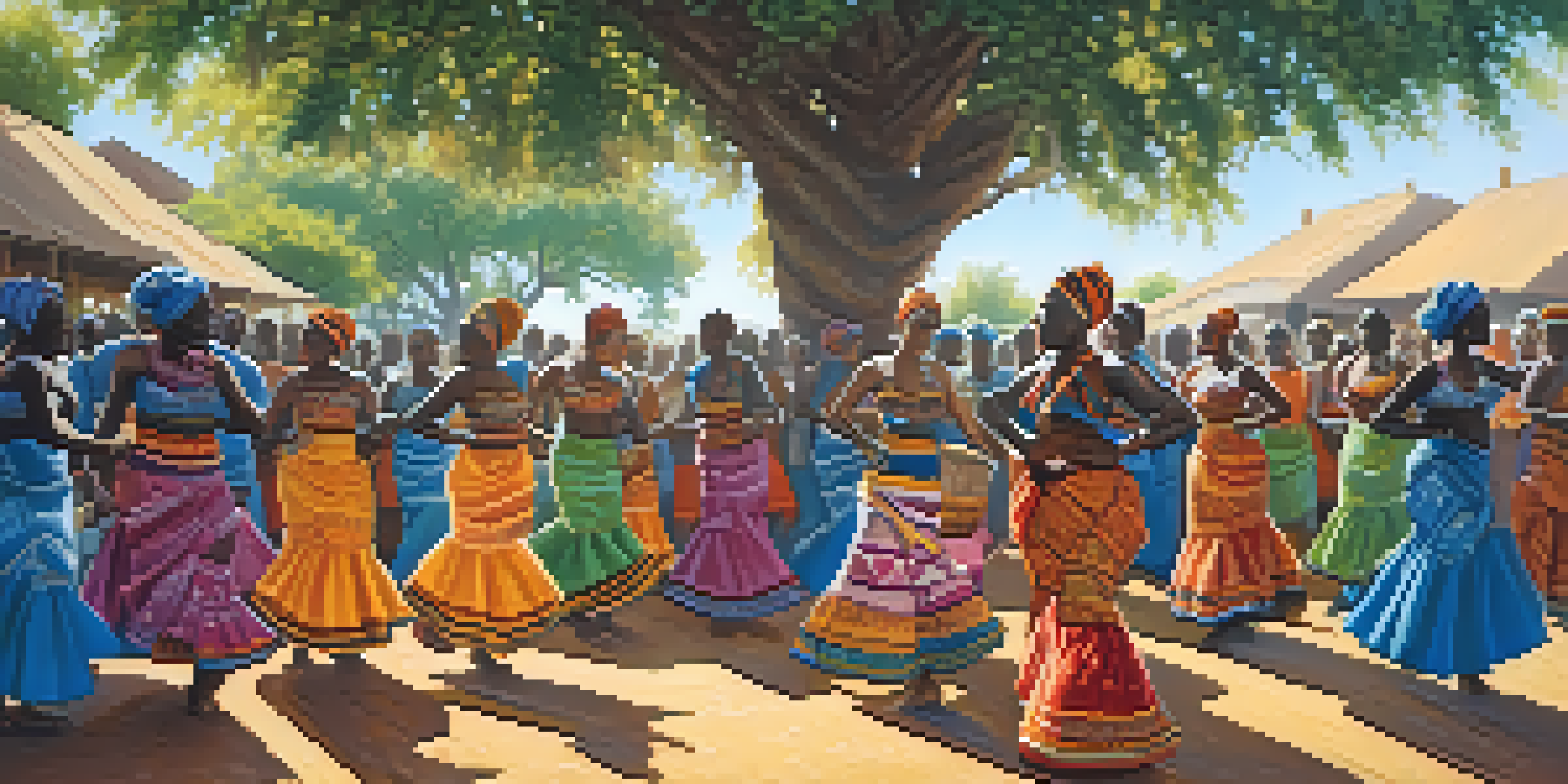Cultural Rhythms: The Dance of Music Across Different Cultures

The Universal Language of Music and Dance
Music and dance serve as a universal language, transcending borders and cultures. They connect people through emotion and expression, often resonating with shared human experiences. Whether it’s a joyous celebration or a somber ritual, the rhythms of music and dance help convey what words sometimes cannot.
Music is the universal language of mankind.
Consider how a simple drumbeat can evoke feelings of joy or nostalgia; it’s a powerful reminder of our collective experiences. For instance, many cultures use music during life milestones like weddings or funerals, reinforcing community bonds. This shared use highlights a fundamental truth: music and dance are integral to human life.
As we explore different cultures, we see how music and dance adapt to local customs and traditions, yet the underlying emotions remain the same. This adaptability showcases the resilience and creativity of human expression across diverse societies.
African Rhythms: The Heartbeat of Community
In many African cultures, music and dance are deeply woven into the fabric of community life. From the vibrant drumming of the Djembe to the graceful movements of traditional dance, every performance tells a story. These art forms often serve not just for entertainment, but as a means of communication and cultural preservation.

Take, for example, the Griot tradition in West Africa, where storytellers use music to pass down history and wisdom. Their performances are lively, engaging the audience in a shared journey through time. This practice highlights how music and dance foster a sense of belonging and continuity.
Music and Dance Unite Cultures
Music and dance transcend borders, connecting people through shared emotions and experiences.
Moreover, African music often incorporates call-and-response patterns, encouraging participation from the audience. This interaction transforms spectators into active participants, reinforcing community ties and shared cultural identity.
Latin American Beats: A Fusion of Cultures
Latin American music is renowned for its vibrant rhythms and rich cultural influences. Genres like salsa, tango, and samba exemplify the fusion of indigenous, African, and European traditions. This blend creates a lively and dynamic musical landscape that invites people to dance and celebrate.
Dance is the hidden language of the soul.
Take the tango, for instance, born in the streets of Buenos Aires. Its passionate movements and intricate footwork reflect the complex emotions of love and longing. Tango not only entertains but also serves as a cultural narrative, telling stories of migration and social change.
Similarly, salsa music originated in the Caribbean and has since spread globally, becoming a symbol of cultural pride. Its infectious rhythm encourages social interaction, fostering community bonds through dance. In this way, Latin American music illustrates the power of cultural exchange.
Asian Melodies: Spirituality and Harmony
In many Asian cultures, music often embodies spiritual and philosophical concepts. From the meditative sounds of Indian classical music to the intricate melodies of Chinese orchestras, these traditions seek to create harmony both within the individual and with the universe. Music is seen as a pathway to spiritual enlightenment.
For example, in Tibetan culture, chanting and the use of traditional instruments like the singing bowl promote mindfulness and peace. These practices highlight the connection between music and well-being, inviting listeners to reflect and find internal balance.
Cultural Heritage Through Performance
Many cultures use music and dance as vital tools for preserving heritage and teaching traditions.
Moreover, the art of dance in Asian cultures, such as Bharatanatyam in India, is rich with symbolism and storytelling. Dancers use their bodies to convey narratives that celebrate mythology and nature, reinforcing cultural values and teachings through performance.
European Traditions: History in Motion
European music showcases a vast array of styles and traditions, each reflecting the continent's rich history. From classical symphonies to folk dances, these musical forms often narrate the stories of their people. They serve as a window into the past, revealing cultural evolution and historical context.
Consider the role of folk music in various European regions; it often captures the spirit of local life, expressing joy, sorrow, and resilience. For instance, Irish folk music, with its lively jigs and heartfelt ballads, is rooted in both celebration and remembrance of struggles.
Additionally, classical music, with composers like Beethoven and Mozart, paved the way for artistic expression that continues to influence modern music. Their timeless compositions remind us of the enduring power of music to transcend time and place.
Indigenous Voices: Preserving Heritage Through Dance
Indigenous cultures around the world use music and dance as vital tools for preserving their heritage. These art forms play a crucial role in storytelling, teaching younger generations about traditions, values, and history. They often reflect a deep connection to the land and spirituality.
For example, Native American powwows feature traditional dances and drumming that celebrate community and culture. These gatherings not only honor ancestral practices but also foster unity among diverse tribes. They serve as a vibrant reminder of resilience in the face of historical challenges.
Everyday Joys of Music and Dance
Music and dance enhance our daily lives, uplifting spirits and fostering connections among individuals.
Furthermore, many indigenous songs are tied to specific rituals and ceremonies, reinforcing cultural identity. By participating in these performances, community members strengthen their ties to their ancestors and cultivate a sense of belonging.
The Contemporary Scene: Blending Traditions
In today's globalized world, music and dance continue to evolve, often blending traditional styles with contemporary influences. This fusion creates exciting new genres that resonate with diverse audiences, bridging cultural gaps and fostering understanding. Artists are increasingly drawing inspiration from their roots while incorporating modern elements.
Take K-Pop, for instance, which combines traditional Korean music with Western pop influences, creating a global phenomenon. Its catchy tunes and intricate choreography have captivated audiences worldwide, showcasing the power of cultural exchange.

Similarly, the rise of world music festivals highlights the growing interest in diverse musical traditions. These events celebrate the richness of global music, encouraging collaboration among artists from different backgrounds. As a result, music and dance become powerful vehicles for unity and shared experience.
The Power of Music and Dance in Everyday Life
Beyond cultural significance, music and dance play an essential role in our everyday lives. They can uplift our spirits, enhance our well-being, and create lasting memories. Whether it's dancing at a wedding or listening to a favorite song on the way to work, these experiences enrich our daily routines.
Consider how music often accompanies our emotions; upbeat tunes can energize us, while calming melodies can provide solace. This connection to our feelings makes music a powerful tool for self-expression and healing.
Moreover, participating in dance can be a joyful way to connect with others, breaking down barriers and fostering friendships. In this way, music and dance not only reflect cultural traditions but also enhance our personal lives, reminding us of our shared humanity.